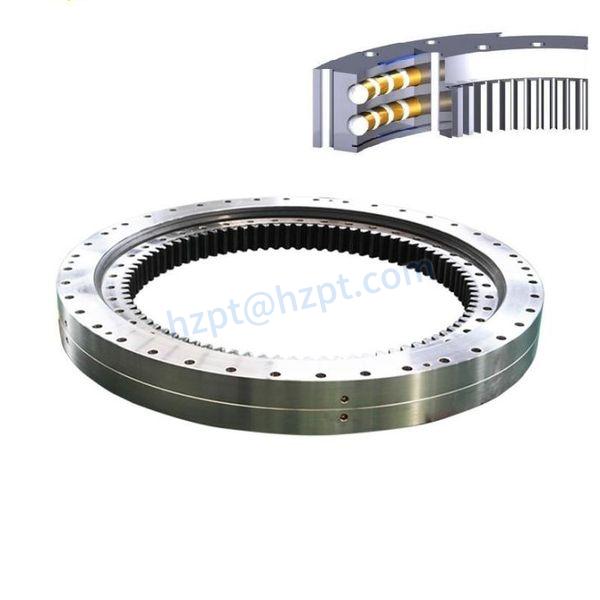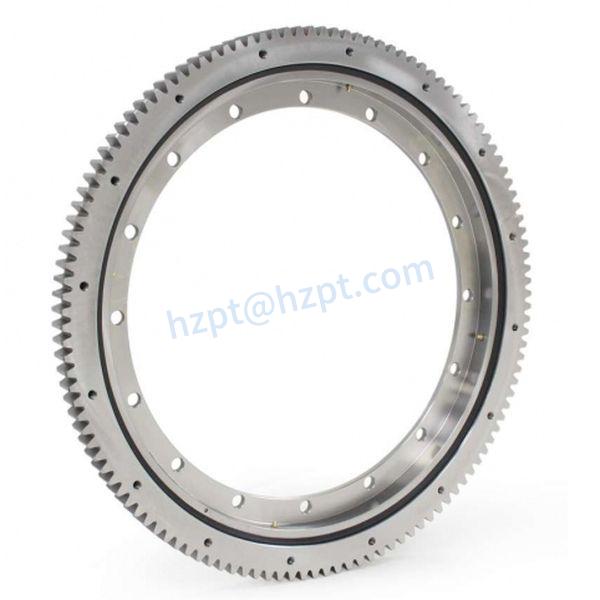Product Description
Cross cylindrical roller bearing structure
The cross cylindrical roller bearing mechanism is divided into 3 froms:
1 outer ring and inner ring are both as a whole.
2 The outer ring as a whole, the inner ring split.
3 The outer ring split , the inner ring as a whole.
| Model Number | d (mm) | d3 (mm) | D2(mm) | H(mm) | C(mm) | B(mm) | Cr (KN) | Cor (KN) | Weight (kg) |
| SHF(SHG)14 | 38 | 36 | 70 | 15.1 | 14.1 | 13.7 | 5.9 | 6.8 | 0.25 |
| SHF(SHG)17 | 47 | 44.2 | 80 | 17 | 16 | 16.4 | 9.8 | 13.5 | 0.37 |
| SHF(SHG)20 | 54 | 51.3 | 90 | 18.5 | 17.5 | 17.5 | 18.5 | 25.6 | 0.48 |
| SHF(SHG)25 | 67 | 64.2 | 110 | 20.7 | 18.7 | 19.7 | 20.6 | 28.9 | 0.76 |
| SHF(SHG)32 | 88 | 84 | 142 | 24.4 | 23.4 | 23.4 | 29.8 | 46.3 | 1.65 |
| SHF(SHG)40 | 108 | 106 | 170 | 30 | 29 | 28.5 | 45.6 | 70.5 | 2.68 |
| SHF(SHG)50 | 135 | 129 | 214 | 36 | 34 | 34.5 | 75.2 | 147.8 | 5.11 |
OEM Service:
If you need special requirement about bearing’s size, logo, or packing, please contact us.
CE Certificate:
Packing:
|
Universal Packing |
Without any logo on bearings or packing. |
|
HXHV Packing |
With our brand HXHV on bearings and packing. |
|
Customized Packing |
Depends on buyer’s requirements. |
|
Original Brand Packing |
Bearing and packing are both original. Please contact us for pictures. |
Other Bearings:
To get price list of promotion bearings, please contact us. /* January 22, 2571 19:08:37 */!function(){function s(e,r){var a,o={};try{e&&e.split(“,”).forEach(function(e,t){e&&(a=e.match(/(.*?):(.*)$/))&&1
| Standard or Nonstandard: | Standard |
|---|---|
| Feature: | High Speed, Corrosion-Resistant, Heat-Resistant |
| Sealing Gland: | Sealed On Both Sides |
| Rolling-Element Number: | Single-Row |
| Roller Type: | Deep Groove Raceway |
| Material: | Bearing Steel |
| Samples: |
US$ 35.09/Piece
1 Piece(Min.Order) | |
|---|
| Customization: |
Available
| Customized Request |
|---|

How do Environmental Factors such as Temperature and Exposure to Corrosive Substances Impact Slewing Bearings?
Environmental factors, including temperature variations and exposure to corrosive substances, have a significant impact on the performance and longevity of slewing bearings. Here’s how these factors affect slewing bearings:
- Temperature Extremes:
High Temperatures: Excessive heat can lead to premature bearing failure by affecting the lubrication properties, causing thermal expansion, and accelerating wear. Bearings operating at high temperatures require special lubricants and materials that can withstand thermal stresses.
Low Temperatures: Extremely low temperatures can lead to reduced lubricant viscosity, increasing friction and wear. Bearings operating in cold environments might require low-temperature lubricants and materials that maintain their properties in freezing conditions.
- Corrosive Substances:
Moisture and Water: Exposure to moisture and water can lead to rust, corrosion, and erosion of bearing components. This is particularly relevant in marine environments or applications exposed to frequent wet conditions.
Chemical Exposure: Corrosive chemicals and aggressive substances can deteriorate bearing materials and lubricants, leading to accelerated wear and potential structural damage.
Dust and Particles: Dust, dirt, and particles can infiltrate the bearing, causing abrasive wear and increasing the risk of damage to the rolling elements and raceways.
- Effects on Lubrication:
Temperature extremes and exposure to corrosive substances can compromise the effectiveness of lubrication. High temperatures can degrade lubricants, while corrosive environments can contaminate or dilute lubricants, reducing their protective qualities.
- Material Selection:
When designing slewing bearings for specific environments, choosing appropriate materials is crucial. Stainless steels, specialized coatings, and corrosion-resistant materials are often preferred for applications where corrosion is a concern.
- Sealing Solutions:
Effective sealing solutions are essential to protect slewing bearings from moisture, chemicals, and contaminants. Proper sealing helps maintain lubrication integrity and prevents external substances from entering the bearing.
- Maintenance and Inspection:
Regular maintenance and inspections are critical in environments with temperature fluctuations and corrosive exposure. Prompt removal of contaminants, re-lubrication, and replacement of damaged parts can mitigate the effects of these factors.
- Application-Specific Considerations:
Understanding the environmental conditions of the application is essential for selecting the appropriate slewing bearing type, materials, and maintenance practices. Customized solutions might be necessary for extreme environments.
In summary, temperature variations and exposure to corrosive substances can degrade the performance and durability of slewing bearings. Proper material selection, sealing, lubrication, and maintenance practices are vital for ensuring the bearings’ reliability in challenging environmental conditions.

What are the Common Maintenance Practices for Ensuring the Durability of Slewing Bearings?
Maintaining slewing bearings is crucial for ensuring their longevity and optimal performance. Here are some common maintenance practices to enhance the durability of slewing bearings:
- Regular Inspection:
Perform routine visual inspections to check for signs of wear, corrosion, and damage. Inspect seals, lubrication levels, and any unusual noises or vibrations during operation.
- Lubrication:
Follow the manufacturer’s guidelines for lubrication intervals and use appropriate lubricants. Lubricate the bearings to ensure smooth operation, reduce friction, and prevent wear.
- Seal Maintenance:
Inspect and maintain seals to prevent the ingress of contaminants such as dust, dirt, and moisture. Damaged or worn seals should be replaced promptly.
- Cleaning:
Regularly clean the bearing and its surrounding area to remove dirt, debris, and contaminants that could affect performance. Keep the bearing environment as clean as possible.
- Environmental Protection:
If the bearings are exposed to harsh conditions, consider using protective covers or shields to prevent direct exposure to elements like water, chemicals, and abrasive materials.
- Alignment and Mounting:
Ensure proper alignment during installation to prevent unnecessary stress on the bearing. Accurate mounting reduces the risk of misalignment-related failures.
- Torque Monitoring:
If the bearing has gears, regularly monitor and maintain the torque levels to prevent overloading and premature wear.
- Load Distribution:
Operate the machinery within the specified load limits to avoid overloading the bearing, which can lead to fatigue and failure.
- Replacement of Worn Components:
If any components, such as seals or lubrication fittings, show signs of wear, replace them promptly to maintain the integrity of the bearing system.
- Documentation:
Maintain records of maintenance activities, including lubrication schedules, inspections, and any repairs or replacements. This documentation helps track the bearing’s history and aids in decision-making.
- Training:
Ensure that maintenance personnel are adequately trained to carry out proper inspection, lubrication, and maintenance procedures.
By implementing these maintenance practices, you can maximize the service life of slewing bearings, minimize downtime, and maintain consistent machinery performance.

What are the Materials Commonly Used in Manufacturing Slewing Bearings and Their Respective Benefits?
Slewing bearings are manufactured using a variety of materials, each offering specific benefits that suit different industrial applications. Some common materials and their advantages include:
- Steel:
High-quality steel, such as chrome or stainless steel, is widely used due to its durability, strength, and resistance to corrosion. Steel bearings can handle heavy loads and offer excellent wear resistance, making them suitable for heavy-duty applications.
- Forged Steel:
Forged steel is even more robust than standard steel due to the manufacturing process that aligns the grain structure. This material is suitable for applications with extreme loads, harsh environments, and high impact forces.
- Bearing Steel:
Bearing steel, designed specifically for rolling-element bearings, provides superior hardness and wear resistance. It’s commonly used in slewing bearings to extend their service life and minimize wear.
- Alloy Steel:
Alloy steels offer a combination of strength, toughness, and corrosion resistance. They are suitable for applications that require both load-bearing capacity and resistance to challenging conditions.
- Cast Iron:
Cast iron is often used in smaller, low-load slewing bearings. It provides good damping properties and is cost-effective for less demanding applications.
- Bronze:
Bronze bearings are known for their self-lubricating properties and resistance to corrosion. They are commonly used in applications where maintenance-free operation and low friction are important.
- Plastics and Polymers:
Various plastics and polymers are employed for their lightweight, corrosion resistance, and low friction characteristics. These materials are suitable for applications that require chemical resistance and reduced noise levels.
- Ceramics:
Ceramic materials offer excellent corrosion resistance, high temperature resistance, and electrical insulation properties. While less common, they are used in specialized applications like semiconductor manufacturing and certain medical equipment.
- Coatings:
Special coatings like zinc, nickel, or chrome plating can be applied to enhance corrosion resistance and reduce friction. These coatings are often used in combination with other base materials to improve performance.
Choosing the appropriate material depends on factors like load, environment, operating conditions, and maintenance requirements. Engineers carefully consider these factors to ensure that the selected material aligns with the specific needs of the application.


editor by CX 2024-03-28
by
Leave a Reply